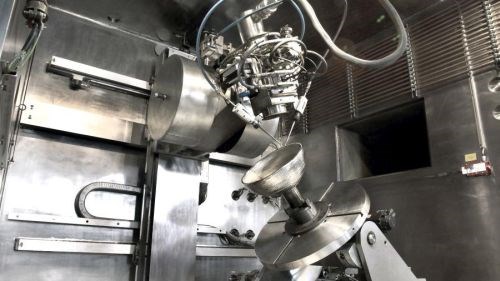Freedom in Electron Beam Additive Manufacturing
The wire-fed EBAM process offers flexibility in part geometry and size—as well as material properties.

Sciaky’s EBAM system is equipped with two wire feeders that travel with the electron beam head, enabling the building of large parts.
Electron Beam Additive Manufacturing (EBAM) holds plenty of possibilities for metal AM applications. The process builds parts using an electron beam to melt metal wire that travels with the beam head. In contrast to powder bed systems in which the size of the part is limited by the size of the bed, parts built on an EBAM system can be as large as the machine’s travels permit.
This capacity for building large parts plus its speed gives EBAM clear potential as an alternative to forging. Like forging, it is a near-net-shape process capable of building large forms. But unlike forging, it requires no die or other tooling, making it faster and more flexible. EBAM can provide design freedoms in geometry that forging cannot.
But perhaps more significantly, EBAM also provides material freedom. Chicago-based Sciaky has developed an EBAM system that allows for two different wires to be fed into the machine. This dual-fed system could be used to deposit two spools of wire simultaneously, increasing throughput, or loaded with both large-diameter and fine wire to provide a range of detail. However, its greatest potential may lie in the ability to blend wires of two different alloys within the same build, creating a proprietary alloy or even a gradient between materials.
Read more about the possibilities of EBAM and how Lockheed Martin is building propellant tank components with this technology on Additive Manufacturing magazine’s website.
Related Content
-
Using Topology Optimization to Lightweight: A Paradox for Machining
Today’s computer software can just as easily generate lightweight shapes for subtractive processes as it can for additive ones, but it increases cost and waste to make them.
-
Additive/Subtractive Hybrid CNC Machine Tools Continue to Make Gains (Includes Video)
The hybrid machine tool is an idea that continues to advance. Two important developments of recent years expand the possibilities for this platform.
-
SolidCAM Wants to Help Machine Shops Get into Additive Manufacturing
SolidCAM's partnership with Desktop Metal is aimed at making additive manufacturing more accessible to job shops and other manufacturers.

.jpg;width=70;height=70;mode=crop)











